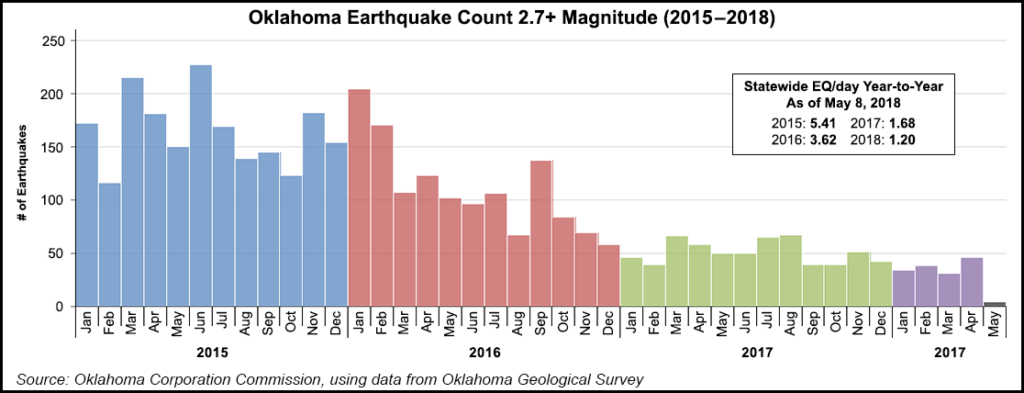Regulatory | NGI All News Access | NGI The Weekly Gas Market Report
Oklahoma Calls For Disposal Well Volume Cuts After Pair of April Quakes
In response to a pair of earthquakes in north-central Oklahoma last month, state regulators have directed operators of nearly two dozen wastewater disposal wells to cut back on volumes and to perform additional testing.

On Tuesday, the Oklahoma Corporation Commission’s (OCC) Oil and Gas Conservation Division (OGCD) issued a directive for 23 disposal wells located within a 10-mile buffer zone of the two quakes to reduce their average daily volumes by 20%. The division also said operators that had reduced the depth of their wells will be required to verify each well’s bottom hole plug integrity.
The directive comes after two earthquakes struck Garfield County in April, near the town of Covington. According to the Oklahoma Geological Survey (OGS), a 4.6-magnitude temblor struck on April 7, followed by a 4.0-magnitude quake two days later. OGS data indicates the epicenter of the first quake was about six miles south of Covington, while the second quake’s epicenter was about four miles east-southeast of the town.
Regulators created the 10-mile buffer zone by creating an axis between the epicenters of the two quakes and then making an outward expansion. A map provided by OGCD shows 14 of the 23 wells subject to the directive are in Garfield County, while an additional 10 wells are in neighboring Logan County and the remaining two wells are in Noble County.
OGCD said the directive will reduce daily volumes by an average of 11,226 bbl.
Last month, the OCC ordered Choate Disposal Services LLC to cease operations at its Choate SWD No. 1 well, which is located in neighboring Kingfisher County.
OCC and OGCD have been attempting to mitigate induced seismic activity across the state since 2015. The agencies have focused on wastewater injection wells targeting the Arbuckle — especially the Mississippian Lime and the Hunton Dewatering play — within a 15,000-square mile area of interest in the state.
Scientists with the OGS attribute many of the recent quakes to the disposal of extremely salty water, a byproduct of oil and gas production, via underground injection wells.
© 2024 Natural Gas Intelligence. All rights reserved.
ISSN © 2577-9877 | ISSN © 1532-1266 | ISSN © 2158-8023 |
